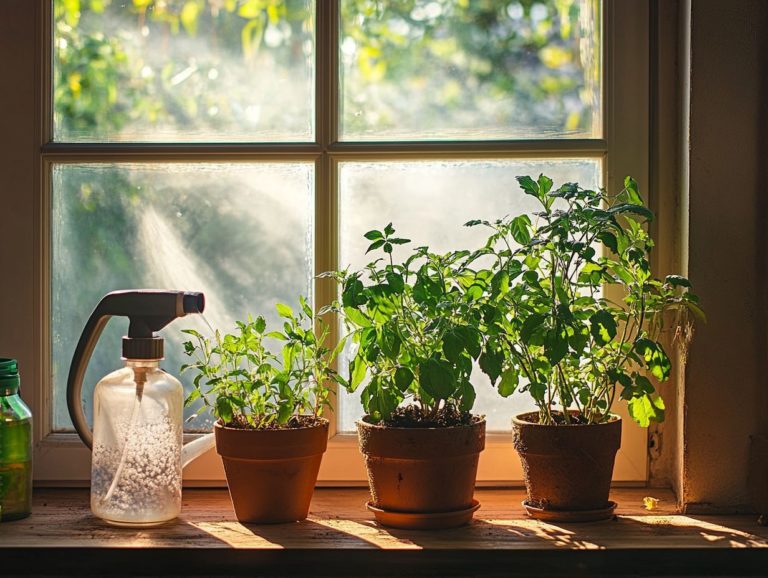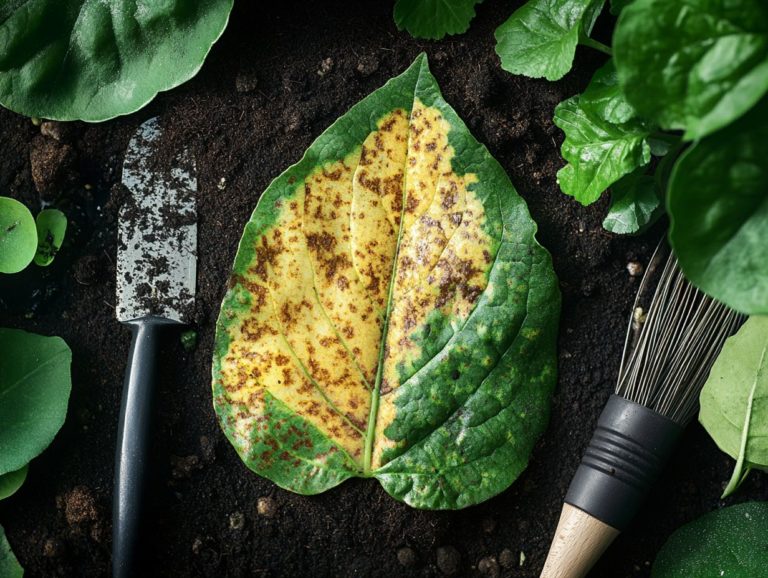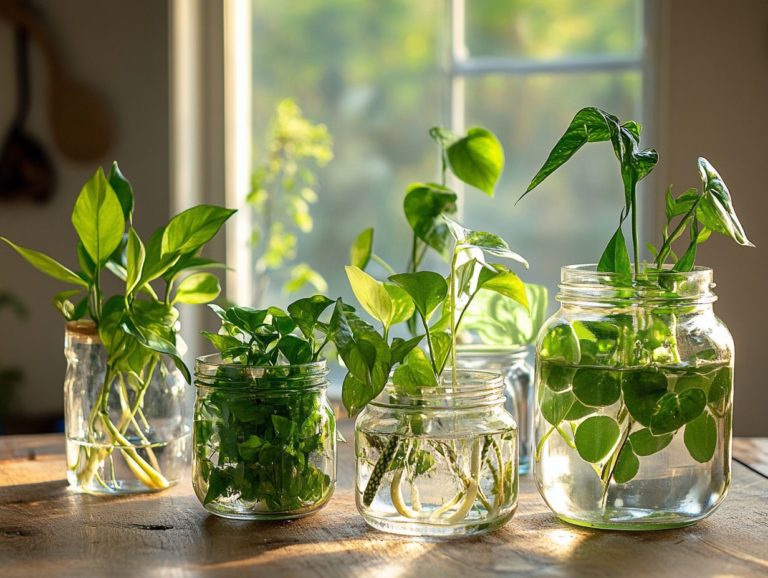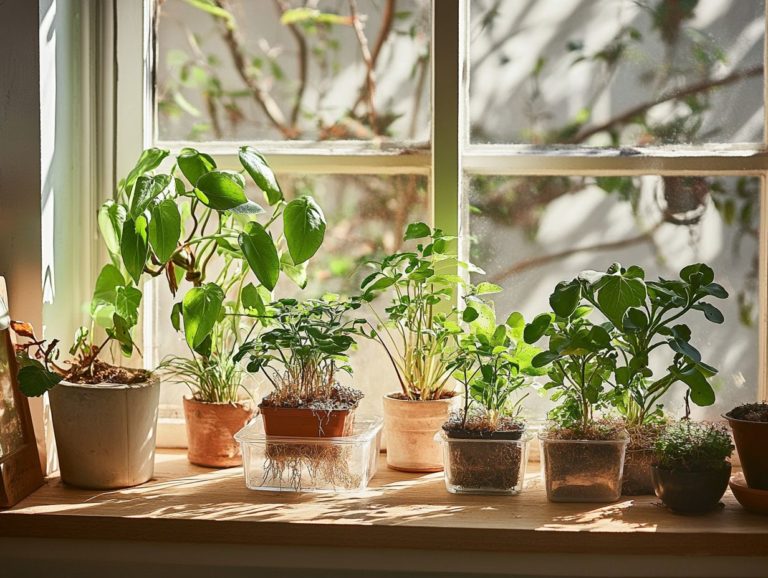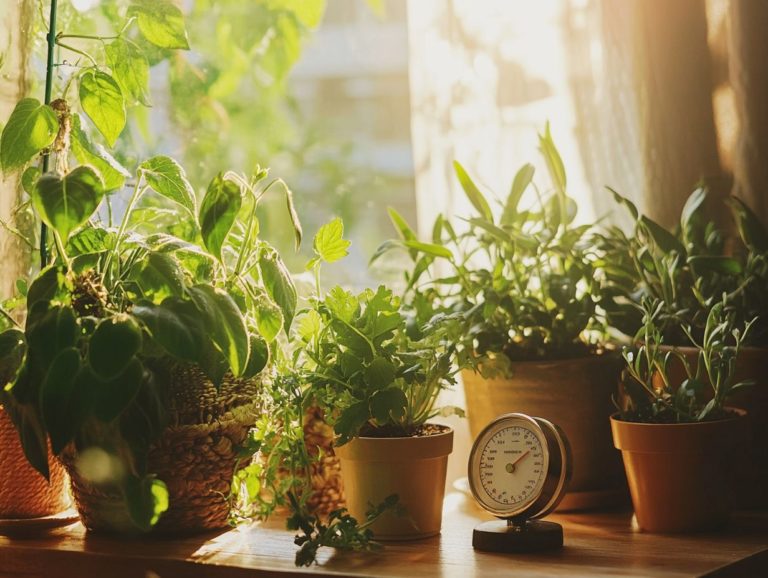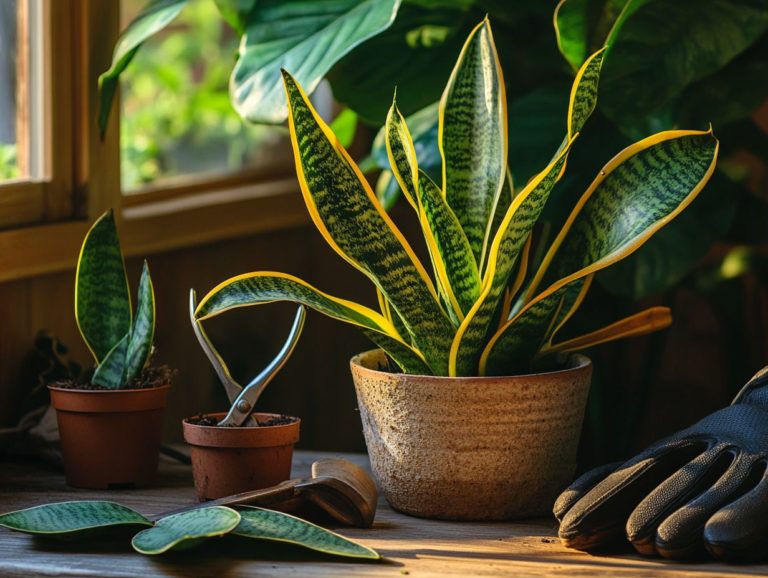How to Propagate ZZ Plants
ZZ plants, with their glossy leaves and remarkable resilience, have earned a well-deserved spot in the hearts of indoor gardeners like you. This low-maintenance plant is often favored for its ease of care.
If you re eager to expand your collection or share these stunning plants with friends, propagating ZZ plants is not only rewarding but also a surprisingly simple endeavor.
This guide will delve into the benefits of propagation and walk you through various methods, such as leaf cuttings, stem cuttings, and rhizome division, complete with a handy step-by-step approach. This guide will also address common challenges you might encounter along the way, including pest issues and common problems. Get ready to nurture your green thumb!
Contents
Key Takeaways:
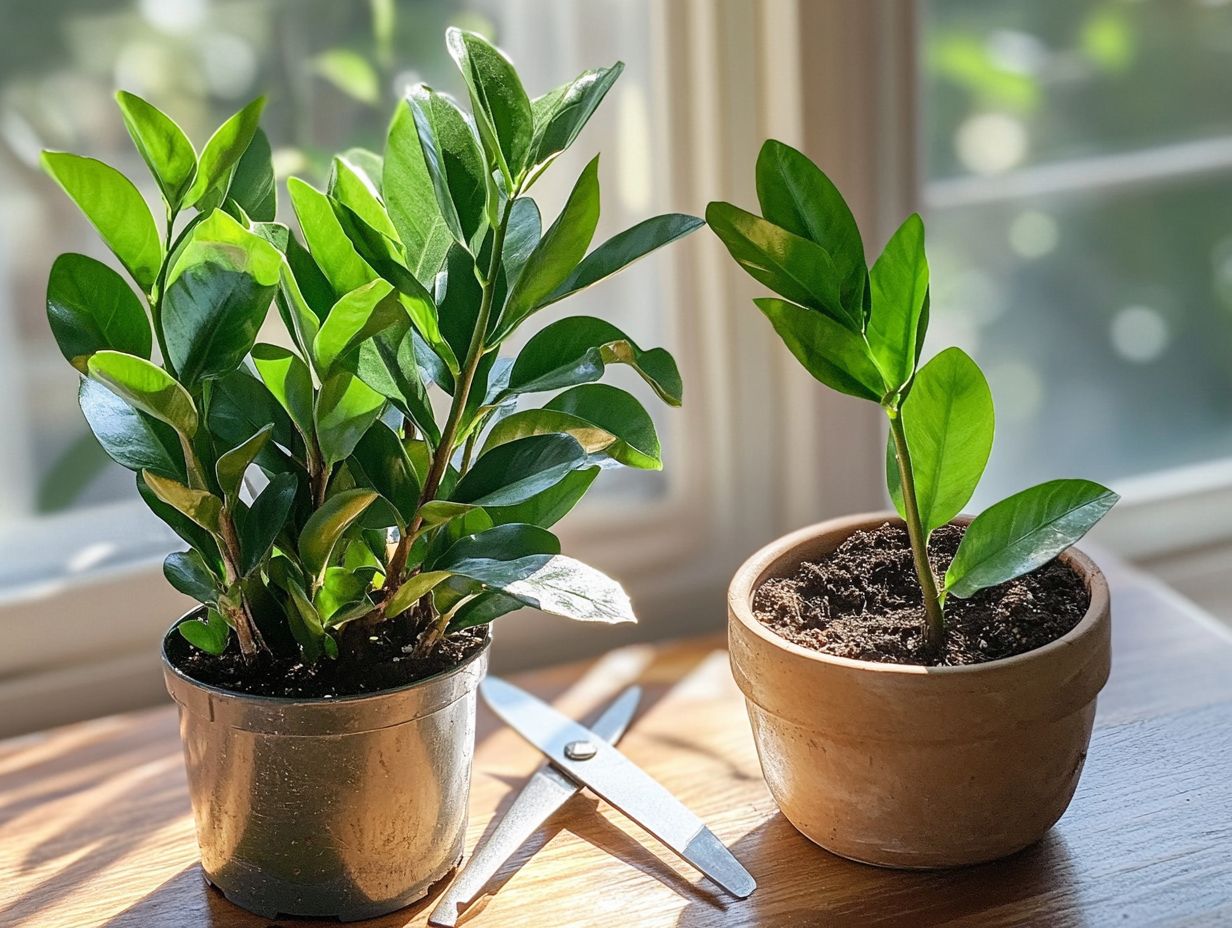
- Propagating ZZ plants can help you expand your plant collection and share its benefits with others.
- Leaf cuttings and rhizome division are two effective methods for propagating ZZ plants.
- Spring and summer are the best times to propagate ZZ plants. Proper care during the process can prevent common issues such as pests and diseases.
What are ZZ Plants?
ZZ plants, scientifically known as Zamioculcas zamiifolia, are your go-to resilient indoor companions, coming from the lush landscapes of eastern Africa, particularly southern Kenya and South Africa. With their striking glossy leaves and remarkable ability to thrive in low-light conditions, ZZ plants have effortlessly carved a niche for themselves among houseplant enthusiasts.
These low-maintenance gems are perfect for both novices and seasoned plant lovers looking to enhance their indoor spaces without diving deep into gardening complexities. They store water in their rhizomes, making them ideal for busy plant owners.
What sets them apart is their thick, waxy foliage that not only catches the eye but also bolsters their drought resistance. When you decide to cultivate these beauties, remember to provide well-draining soil and steer clear of overwatering; too much moisture can spell trouble with root rot.
They adapt effortlessly to various environments, whether it s a dimly lit corner or a sunny windowsill. This showcases their incredible versatility and makes them a favorite among houseplant collectors.
Often cherished for their hardiness and stunning appearance, ZZ plants infuse your home with a touch of the exotic, combining aesthetic allure with effortless care.
Why Propagate ZZ Plants?
Propagating ZZ plants presents a wonderful opportunity for you to enhance your indoor garden. This fun process enriches your plant collection and brings joy!
By employing propagation techniques such as stem cuttings, leaf cuttings, or root ball division, you can expertly cultivate new specimens that retain all the desirable traits of the mother plant. This ensures vibrant and healthy growth for years to come.
Benefits of Propagating
The benefits of propagating ZZ plants are numerous. This practice not only encourages new growth but also fosters healthy leaves and strong root development.
When you engage in propagation, you can cultivate new specimens that flourish just as beautifully as the original plant. This ensures a vibrant presence of greenery in your indoor space.
By understanding the intricacies of houseplant care, you can navigate common challenges encountered during propagation. This ultimately leads to a higher success rate and the sheer joy of nurturing new life.
This method enhances your indoor environment by improving air quality and adding a refreshing touch of nature to your decor. It’s important to know that air quality refers to the cleanliness of the air in your home, which can be improved by plants.
Sharpening your propagation skills allows for personal satisfaction and growth as a gardener. However, it’s crucial to be mindful of issues like overwatering or inadequate lighting, as these can hinder growth.
Fortunately, these challenges can be easily managed by monitoring soil moisture and adjusting the plant’s location accordingly. Don’t wait! Start propagating your ZZ plants today for more greenery!
By implementing proper care techniques, you not only maximize your success rate but also enrich your experience as you witness new shoots emerging, transforming a simple hobby into a thriving passion.
Methods of Propagation
You have several effective methods for propagating ZZ plants at your disposal, including stem cuttings, leaf cuttings, and root ball division. Each method is tailored to different preferences and gardening skills, ensuring successful plant propagation.
Water propagation is simple and visually captivating, allowing you to witness the development of new roots before transitioning your new plants to soil. You can also achieve quicker root establishment by using soil propagation, which fosters optimal growth.
Each method boasts unique benefits, making it crucial for you to select one that resonates with your unique gardening style.
Leaf Cuttings
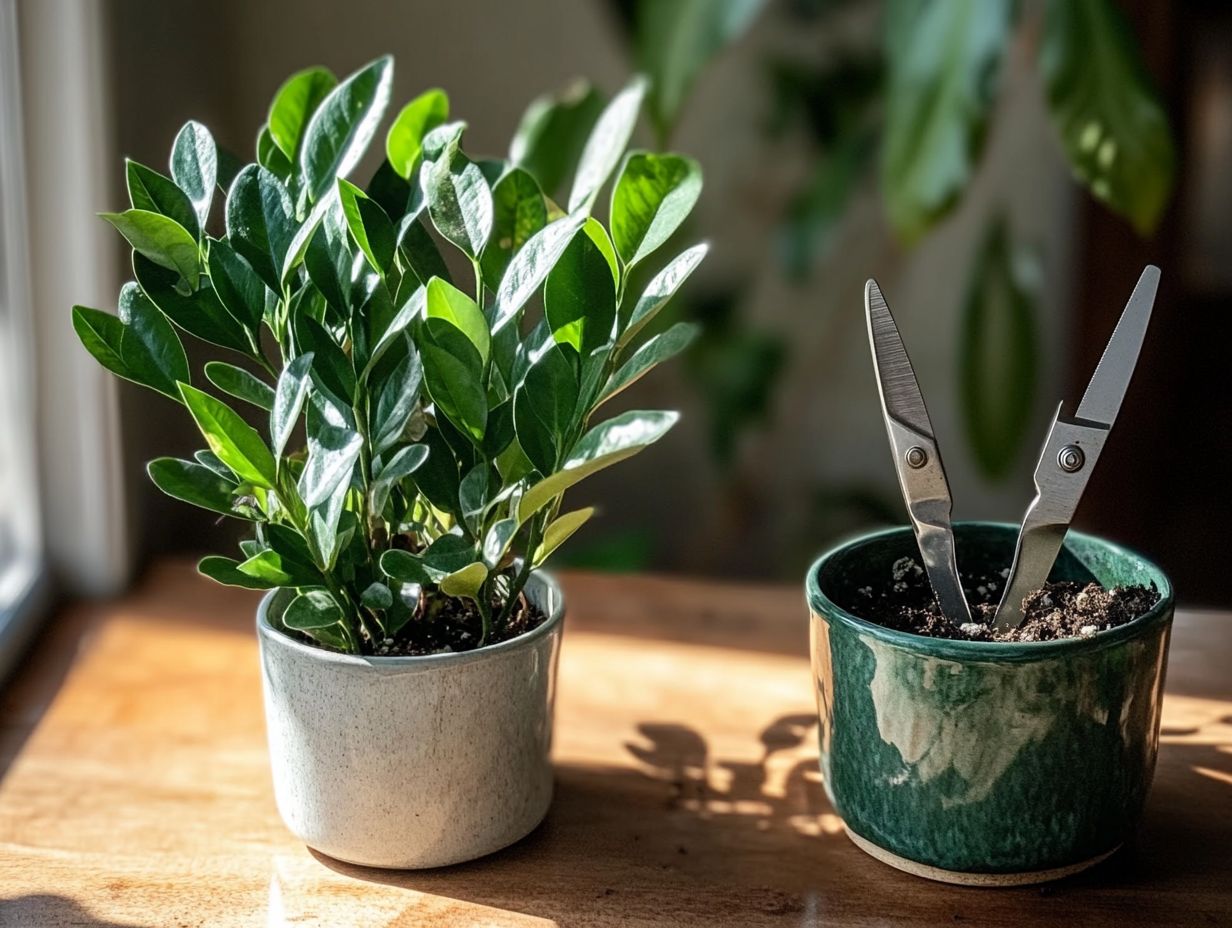
Leaf cuttings are an excellent way for you to propagate ZZ plants, providing an accessible gateway into gardening. To start, select healthy leaves from the mother plant. You can either place these cuttings directly in soil or submerge them in water for propagation.
Rooting may take a few weeks. With diligent care and attention to indirect light and moisture levels, you ll be rewarded with new roots and tiny baby ZZ plants sprouting from your cuttings.
It’s essential to choose robust, mature leaves, as weaker ones may struggle to establish roots. Allowing the cuttings to callus for a day or two before planting can significantly improve your chances of success.
Aim for a warm environment with indirect sunlight. Keep the soil just right moist, but not soggy to let your plants thrive! Regularly monitor conditions to set the stage for optimal growth, enabling your new ZZ plants to flourish beautifully.
Division of Rhizomes
The division of rhizomes stands out as a remarkably effective technique for propagating ZZ plants. This method allows you to cultivate new specimens directly from the established root system of the mother plant. By carefully separating a portion of the root ball, complete with healthy leaves and rhizomes, you can promote robust growth in your new planting. This approach ensures a high success rate and enhances the overall health of the mother plant by alleviating overcrowding.
To execute this process successfully, selecting the right timing is essential spring or early summer during the growing season is ideal when the plant is most active. Start by gently lifting the mother plant from its pot, being mindful to maintain the integrity of the root system. Once exposed, identify plump rhizomes, which are the underground stems that help the plant grow and store nutrients, with healthy leaves attached for optimal growth.
After division, replant the new segments in well-draining soil. Ensure they receive sufficient moisture without the risk of overwatering, which could invite root rot. Keep a close eye on both the new plants and the mother plant for any signs of stress or pest issues. This vigilant monitoring will promote their development and overall vitality.
Choosing the Right Time to Propagate
Selecting the right moment to propagate ZZ plants is essential for fostering optimal growth and achieving a rewarding gardening experience. The prime seasons for propagation are spring and summer, during the growing season, when the plant is naturally predisposed to generate new growth and develop roots.
During these months, the environmental conditions temperature, light, and humidity are more conducive, enabling your cuttings and divisions to establish themselves swiftly and effectively. This results in healthier new plants.
So go ahead and give these methods a shot your new ZZ plants are waiting!
Seasonal Considerations
Understanding seasonal considerations is essential for successfully growing ZZ plants, especially during their prime growing season from spring to summer. These months present optimal light and temperature conditions that spur active growth. This is the ideal time for methods like leaf cutting, stem cuttings, or rhizome division.
As daylight hours extend and temperatures rise, you’ll notice your ZZ plant responding positively. You’ll see new growth and stronger root systems. However, when fall and winter arrive, light diminishes and temperatures drop, causing growth to slow considerably. This period is less conducive to growing new plants, as the plant may enter a dormant phase. During this time, monitor moisture levels carefully and reduce fertilization.
By synchronizing your gardening efforts with these seasonal changes, you can refine your nurturing strategies. This ensures that your ZZ plants flourish throughout the year.
Step-by-Step Guide to Propagating ZZ Plants
A detailed, step-by-step guide to propagating ZZ plants can transform the process into a seamless experience, enabling you to cultivate new plants with confidence. By following straightforward planting instructions and integrating vital care tips such as optimal watering practices and bright light you can significantly enhance your chances of success.
Whether you choose to utilize stem cuttings, leaf cuttings, or rhizome division, understanding each stage of the journey is essential for nurturing thriving ZZ plants. For a comprehensive approach, check out the ultimate guide to ZZ plants.
Preparing the Cuttings or Rhizomes
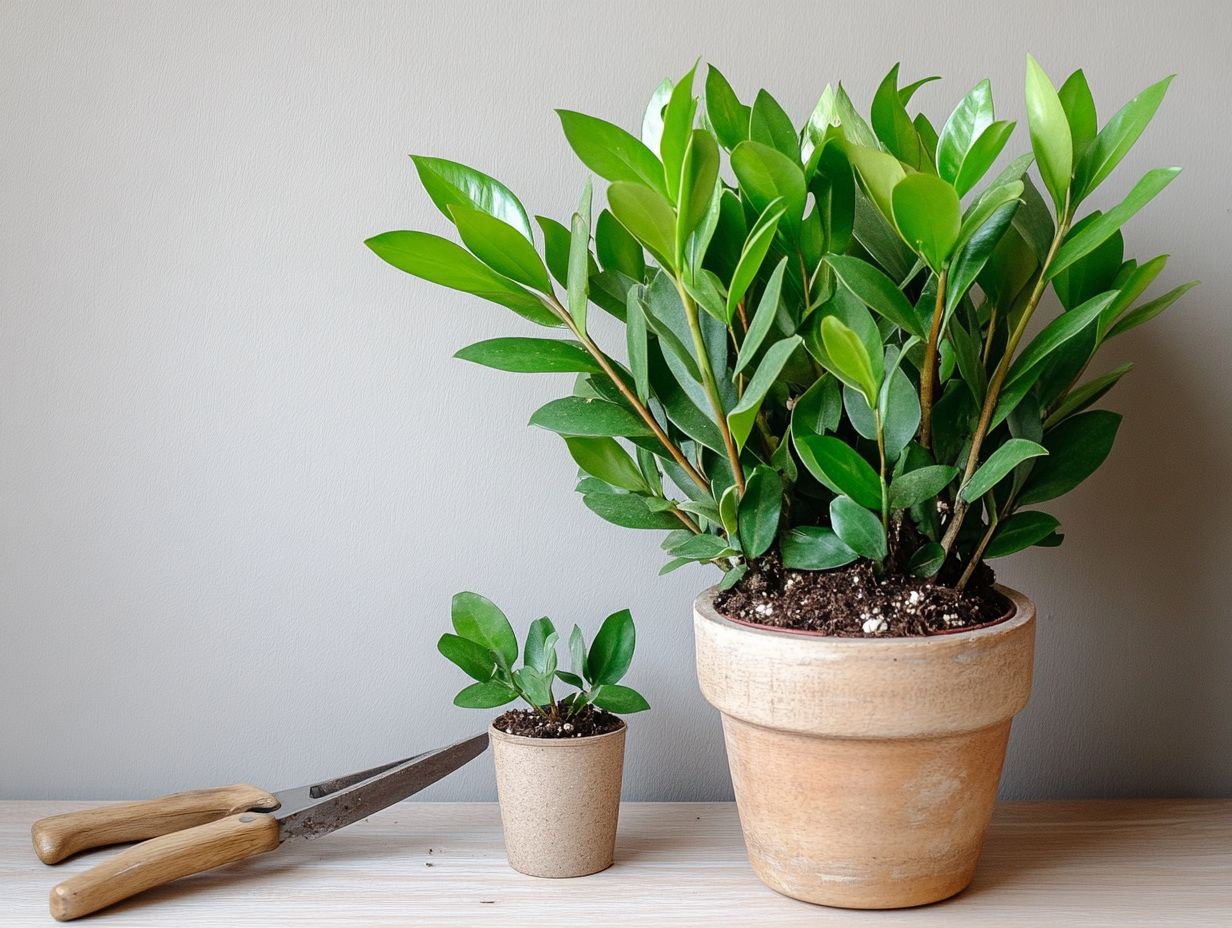
Start by preparing the cuttings or rhizomes. This first step ensures each piece is set up for successful root development.
Remember, cleanliness is paramount during this process. Using clean, sterilized tools can significantly minimize the risk of infections and diseases that could hinder your new growth. When selecting parts of the plant, focus on healthy, firm leaves and healthy rhizome segments, as these are more likely to thrive in their new environment.
Making clean cuts at a 45-degree angle can enhance the surface area for moisture absorption, promoting stronger root establishment. By attending to these details, you elevate plant care beyond mere planting it becomes a journey of creating the best possible environment for new life.
Planting and Caring for New Growth
Once you’ve prepared your cuttings or rhizomes, planting and nurturing the new growth becomes crucial for their health and vitality. Begin by placing the cuttings in well-draining soil, ensuring they receive indirect light to create optimal conditions for root establishment.
Proper watering practices are vital at this stage; overwatering can invite root rot, while underwatering can stifle growth. Keep an eye on the humidity levels around your new plants, as they often thrive in a slightly elevated humidity environment. Using a humidity dome or lightly misting the leaves can help achieve this balance.
Once the roots establish themselves, introduce a diluted liquid fertilizer to provide essential nutrients. This feeding should occur every few weeks to fuel their vigorous growth, especially during the active growing season.
Regularly inspecting for pests and ensuring adequate airflow will further enhance their overall vigor, paving the way for a lush and thriving plant.
Troubleshooting Common Issues
Troubleshooting common issues is crucial for maintaining the health of your ZZ plants throughout the propagation process and beyond. By proactively identifying pest problems and familiarizing yourself with typical challenges, you can implement preventive measures to ensure your plants boast healthy leaves and vigorous growth.
Being aware of potential hurdles enables you to respond swiftly and effectively, protecting your new plants as they take root and flourish.
Get ready to watch your plants thrive! Start propagating your ZZ plants today!
Dealing with Pests and Diseases
Dealing with pests and diseases is an essential part of plant care for every ZZ plant enthusiast. Be ready for challenges, especially in the indoor garden environment.
Pests like spider mites, mealybugs, aphids, and scale insects can sneak into your home, drawn in by the ZZ plant’s lush foliage. Spotting these intruders early is essential. Keep an eye out for discolored leaves, webbing, or a sticky residue on your plants.
Diseases such as root rot, which is a condition where plant roots decay due to excess water, can also emerge as a significant threat. This is particularly likely if your plant is overwatered or if the potting mix holds onto too much moisture.
To avoid these complications, water your plants carefully and allow the soil to dry out between waterings. Use a well-draining potting mix. Regularly inspecting the leaves and stems will help you identify issues before they escalate. Act quickly! Spotting issues early will keep your indoor garden lush and green.
Addressing Growth Problems
Addressing growth issues in your ZZ plants is essential for maintaining healthy leaves and overall vitality. Factors like insufficient light, improper watering practices, or subpar soil conditions can lead to stunted growth or unsightly yellowing leaves.
By pinpointing and resolving these common issues, you can ensure that your ZZ plants thrive, adding a touch of greenery to your indoor spaces. Neglecting these key aspects may result in problems such as drooping stems or root rot, ultimately jeopardizing your plant’s lifespan.
For example, ZZ plants thrive in indirect light, so placing them in areas that are too dim or overly bright can hinder their growth. Overwatering can suffocate the roots, while underwatering leads to desiccation.
To prevent such scenarios, it s crucial to establish a consistent watering routine and use a well-draining potting mix. Implementing these strategies not only promotes robust growth but also elevates the aesthetic appeal of your indoor environment.
Frequently Asked Questions
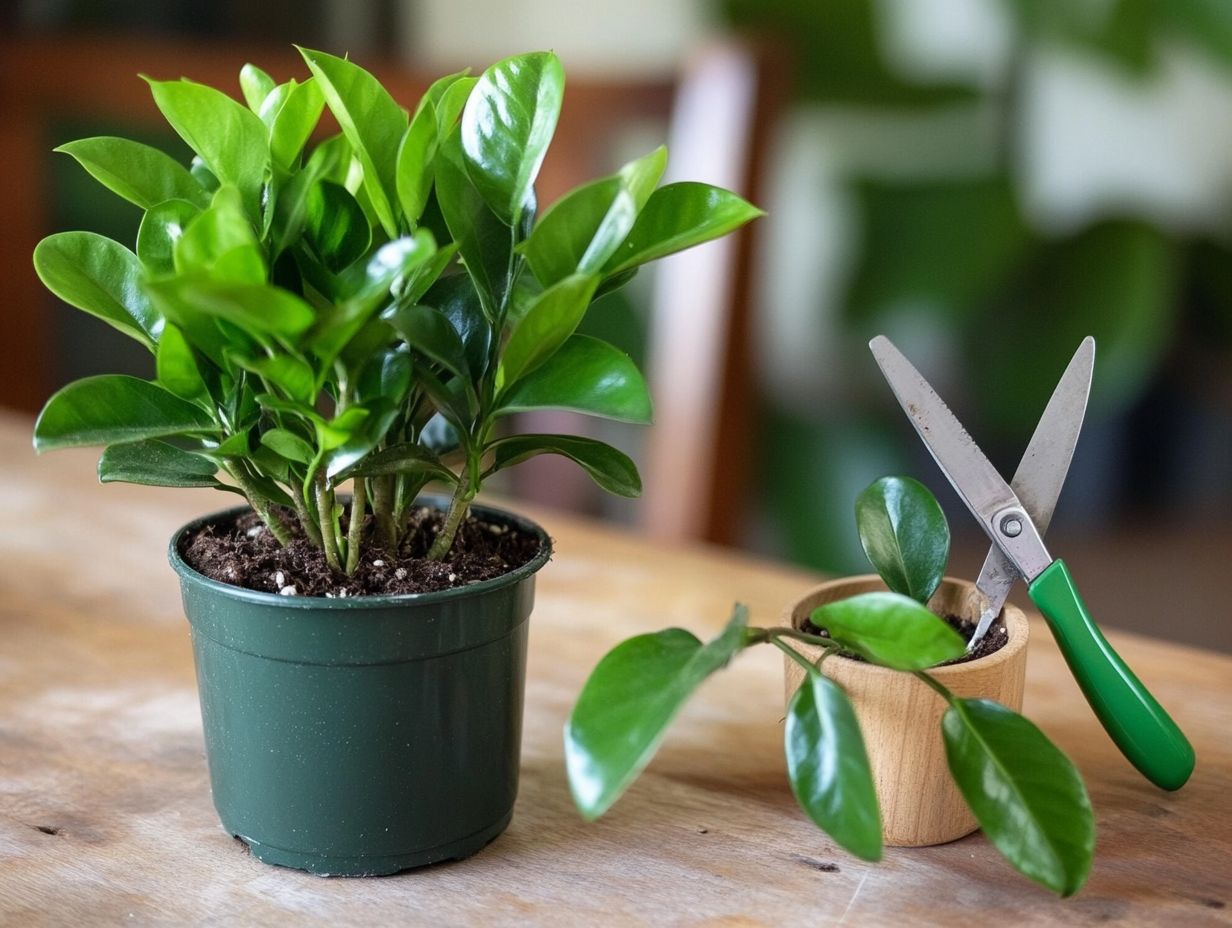
What is a ZZ plant?
A ZZ plant, or Zamioculcas zamiifolia, is a popular houseplant known for its glossy, dark green leaves and easy care requirements. It is native to eastern Africa and is a member of the Araceae family.
How do I propagate ZZ plants?
To propagate ZZ plants, you can either divide the plant into smaller sections or take a leaf cutting. Dividing involves separating the plant, while leaf cuttings mean planting a leaf in soil.
When is the best time to propagate ZZ plants?
The best time to propagate ZZ plants is in the spring or summer when the plant is actively growing. This will give the new plant a better chance of taking root and growing successfully.
What materials do I need to propagate ZZ plants?
To propagate ZZ plants through division, you will need a sharp, clean knife or shears, a pot with well-draining soil, and a rooting hormone (optional). To propagate through leaf cuttings, you will need a healthy ZZ plant leaf, a pot with well-draining soil, and a rooting hormone (optional).
How long does it take for ZZ plants to propagate?
This can vary depending on the method used, but typically ZZ plants will begin showing signs of new growth within a few weeks. However, it may take several months for your new plant to grow to the same size as the original.
Can I propagate ZZ plants in water?
It is not recommended to propagate ZZ plants in water, as they are prone to root rot and may not successfully root in water. It is best to use well-draining soil for propagation to ensure the best chance of success.

